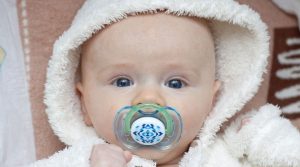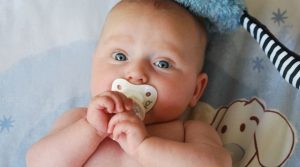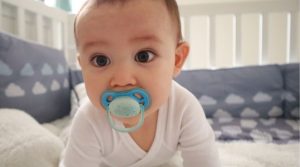Soothing cranky babies and toddlers became a little easier the day pacifiers were invented. They’re a great self-soothing tool for little ones, but like anything else babies use regularly, pacifiers can soon get grimy.
They get dropped on the floor, left between couch cushions and shared with the dog, and since they’re designed to go in the mouth, regular cleaning is obviously essential.
Fortunately, cleaning pacifiers isn’t much different than sterilizing bottles, a process most parents are already used to.
Learning how to clean a pacifier is simple, and, while there are plenty of cool sterilizers on the market that streamline the process, they’re not always necessary.
Related: Baby Pacifiers: Benefits, Risks, and When to Wean
Wondering what you’ll need to get your baby’s binkies clean and sterile?
- Clean, dry rag for wiping and cleaning
- Clean, dry towel for air drying
- Mild dish soap for washing
- Warm water for washing
- A heavy-duty pot for boiling water
Properly sanitizing your baby’s pacifiers
Sanitizing your baby’s pacifier collection is neither difficult nor costly. No special soap or equipment is needed, and old-school methods still work as well as they always have.
Following the five-step process carefully will ensure the baby’s pacifier collection is washed, sanitized, stored properly, and that any damaged or defective binkies have been removed.
Don’t forget to wash your hands before each step of the process, especially when you begin, when drying the pacifiers or removing them from the dishwasher, and, finally, before inspecting them and placing them in storage. 1How to Clean, Sanitize, and Store Infant Feeding Items
cdc.gov
1) Wash with hot water and soap
This is the basic common sense part of the process.
The same mild, touch-safe dish detergent we use to remove bacteria and debris from eating utensils is ideal for cleaning pacifiers, as it cleans deeply, gets rid of germs, and rinses clean.
To make this process truly effective, though, it’s important to wash your hands first. Then, either thoroughly clean your kitchen or bathroom sink, or create a basin by using a plastic tub or large bowl filled with hot water and soap.
Using a brush that’s clean and dedicated to washing only the baby’s feeding items will help clear off any grime left in the crevices. When the pacifiers have been washed, drain, rinse, and wipe them dry.
2) Inspect them for imperfections
As we’ve established, pacifiers have a pretty rugged life journey.
Not only are they being gummed on and bit by kiddos, but get banged around, thrown, or, when they’re just too dirty, shoved into the bottom of a diaper bag to be put aside for this very moment of truth.
While they’re usually pretty sturdy, through long-term use the parts can disconnect or tear, break, chip, and degrade.
Once the pacifiers have all been washed, go back over them with a keen eye. Look for nipples that have chunks missing or are otherwise damaged. 2Pacifier Safety
healthychildren.org
Make sure the parts don’t separate, causing a choking hazard. Such a problem would mean the overall integrity of the pacifier is lost, and, for the baby’s safety, it shouldn’t be used any longer.
Likewise, feel the dried nipples. If any still feel gummy or sticky, it means the material they were made with is beginning to degrade.
Remove these from the collection as they’re no longer safe for your kiddo. Don’t hesitate to replace pacifiers frequently before damage occurs. 3Pacifiers (soothers): A user’s guide for parents
ncbi.nlm.nih.gov
3) Time to sterilize
If you already have an electric or microwave sterilizer, you’re in luck! The manufacturer’s instructions will walk you through the simple process of sterilizing your bottles and pacifiers.
All units operate differently, so make sure to check the instructions before using your device for the best results.
No sterilizer? No problem. Boiling water has been used to sterilize baby gear for years, and it’s just as effective today as it was when our grandparents did it.
Worried about getting it exactly right? We get it — nobody wants to make pacifier soup!
Simply bring a large, clean pot of water to a rolling boil, drop the washed pacifiers in, and allow them to boil for five full minutes before moving on to the next step.
If you’ve got a dishwasher in your home, that’s another option for pacifier sterilization.
Remember to use only the top rack of your dishwasher as the heat produced near the washing mechanism at the bottom is too intense for pacifiers, and they can melt.
Just make sure it’s dishwasher safe before attempting this method (by checking the pacifier’s wrapper,) as those made with latex sometimes can’t hold up to the heat either.
4) Drying and cooling
If you’re using an electric or microwave sterilizer for your pacifiers, it may have a built-in drying feature that can save you from having to establish a specific sterile drying area.
Otherwise, a tidy corner of a clean counter and a clean, dry towel is all that’s needed to air-dry pacifiers.
For the boiling method, once pacifiers have boiled for five minutes, use a sieve to scoop them out of the pot and place them onto a clean, dry towel.
When using a sterilizer without a drying function, simply removing from the unit to the towel is sufficient. Let the pacifiers cool off a bit, then gently shake and dab them to speed up the air-drying process.
While dishwashers do have a drying function, it’s recommended to air-dry pacifiers to maintain the integrity of the material and prevent further unnecessary heat exposure.
5) Storing and preventing contamination
Once you’ve cleaned and sterilized baby’s pacifiers, storing them somewhere that prevents them from becoming contaminated will save you from wasted work.
Sterile containers, or disposable plastic zipper bags, are handy for keeping them free of dirt and germs, though there are numerous creative and sanitary ways to store a binky collection.
Related: Using a Pacifier While Breastfeeding (Truth Bomb!)
Alternate cleaning methods
While not necessarily the most effective ways to clean your kiddo’s pacifiers, these three quick-clean methods are frequently used off-the-cuff to spiff up a dropped pacifier.
Keep in mind that, to truly sterilize your child’s collection, serious heat is needed.
- Sink rinsing. Though it’s better than nothing, it’s not a real wash. Sink rinsing will remove superficial dirt and debris, but doesn’t deal with lingering germs, which require real sanitization to remove.
- Cleaning with saliva. This method certainly doesn’t sound very clean, but it removes surface nasties, and science does suggest that microorganisms from parents give kids an allergy defense boost. 4Pacifier cleaning practices and risk of allergy development
pediatrics.aappublications.org Typically used in a pinch without a place to wash, it’s not a true cleaning method, so we can’t advocate it. - Wiping clean. For the same reason that a water rinse can’t be considered a full pacifier wash, wiping it clean is not our top pick, but it’s an okay choice if a pacifier has been cleaned recently and just needs a little touch up on the run. There are portable packs of pacifier wipes available that are helpful when you’re on the go.
Pacifier storage ideas
At a loss for a sanitary way to store baby’s binky collection? Let’s help you out with a few simple ideas.
- Glass jar/Mason jar. Not only are these sanitary picks when washed, but they’re see-through and a cute way to show off a colorful collection of their faves. Make sure the binkies are dry before placing them inside.
- Plastic storage tub with dividers. This creates easy-access storage for sterile baby stuff. Just reach in, grab and go!
- Small plastic storage dresser. These are inexpensive and can be great for storing small items for babies and toddlers, as they don’t take up much space on a counter or dresser top.
Cleaning pacifiers for your baby needn’t be complicated. Although sanitizers and dishwashers are convenient, the classic boiling water method is cost-free and simple enough for almost any parent to manage.
It’s one way to feel better about your baby’s use of those grimy binkies and a good impetus to weed the scuffed-up ones out of their collection.
Having completed the equation by storing cleaned pacifiers in a dry, sterile place, you can be confident they’ll remain sanitary until ready to be used.





